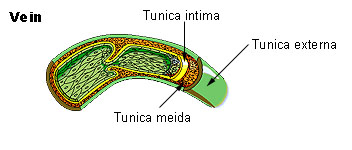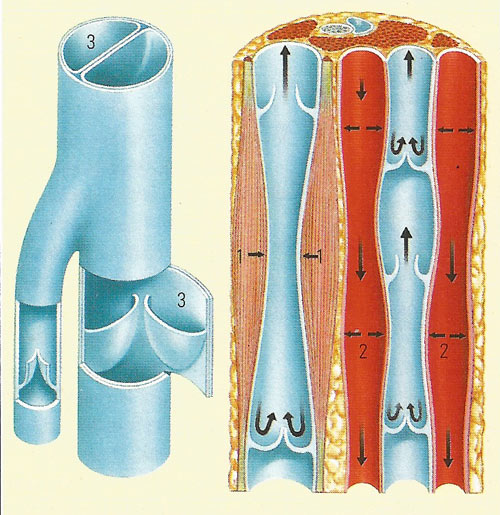vein

The layers in the wall of a vein.

Veins carry blood to the heart. The returning venous blood moves slowly due to low pressure, and the veins can collapse or expand to accommodate variations in blood flow. Movement relies on the surrounding muscles, which contract (1) and compress the vein. Pulsation of adjacent arteries (2) has a regular pumping effect. Semilunar valves (3) are found at regular intervals throughout the larger veins and these allow the blood to move only in one direction.
A vein is a blood vessel that carries blood toward the heart. Veins are wider and more numerous than arteries.
After blood passes through the capillaries, it enters the smallest veins, called venules. From the venules, it flows into progressively larger and larger veins until it reaches the heart. In the pulmonary circuit, the pulmonary veins transport blood from the lungs to the left atrium of the heart. This blood has a high oxygen content because it has just been oxygenated in the lungs. Systemic veins transport blood from the body tissue to the right atrium of the heart. This blood has a reduced oxygen content because the oxygen has been used for metabolic activities in the tissue cells.
Every artery in a limb is accompanied by at least one vein. Most of the superficial arteries and all the larger deep arteries are accompanied by a single vein; the smaller deep arteries have two veins, one on each side, called venae comitantes, united by channels that cross the artery. But, in the superficial fascia, there are numerous veins that do not accompany arteries.
Walls and valves of veins
The walls of veins have the same three layers as the arteries. Although all the layers are present, there is less smooth muscle and connective tissue. This makes the walls of veins thinner than those of arteries, which is related to the fact that blood in the veins has less pressure than in the arteries. Because the walls of the veins are thinner and less rigid than arteries, veins can hold more blood. Almost 70 percent of the total blood volume is in the veins at any given time. Medium and large veins have venous valves, similar to the semilunar valves associated with the heart, that help keep the blood flowing toward the heart. Venous valves are especially important in the arms and legs, where they prevent the backflow of blood in response to the pull of gravity.


